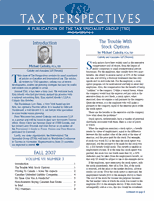
PDF Format
 Issue Contents Issue Contents
 All Issues All Issues
Fall 2007
Volume 7, Number 3
The information in Tax Perspectives is prepared for general interest only. Every effort has been made to ensure that the contents are accurate. However, professional advice should always be obtained before acting and TSG member firms cannot assume any liability for persons who act on the basis of information contained herein without professional advice.
The Trouble With Stock Options
By Michael Cadesky, FCA, TEP
Cadesky and Associates LLP (Toronto)
Stock options have been widely used as the executive compensation tool of choice, from the largest of public companies to small entrepreneurial private businesses. For the employee, they usually have two main benefits: the ability to receive money at 50% of the normal tax rate, and owning a financial instrument that has only upside and no downside risk. For the employer, a stock option program can be motivational and help to retain key employees. Also, the compensation has the benefit of being “cashless” to the company. Unlike a normal bonus, where the company would bear the expense and pay cash to the executive from its own funds, a stock option, when exercised, does not require a cash payment by the company. Quite the reverse, it is the employee who will make a payment to the company, equal to the exercise price under the stock option.
These are the benefits to the executive and the company. Now what about the problems?
Stock options, unfortunately, have a number of potential drawbacks associated with them. Here is a list of points to watch.
When the employee exercises a stock option, a benefit results by virtue of employment, equal to the difference between the fair market value of the stock at the time of exercise, and the price paid for the stock. For example, if stock was worth $12 at the time the stock option was exercised, and the payment to be made for the stock was $2, a $10 benefit would result. This benefit is taxable as employment income. If at the time this stock option was granted, the stock was not worth more than $2, a 50% deduction may be taken from the employment benefit, so that only $5 would be subject to tax in the example above.
If the employee, upon exercising the stock option, sells the stock immediately, then all is fine. But, if the stock is retained, and the price in the market declines, adverse results can occur. Once the stock option is exercised, the employment benefit ($10 in the example above) is fixed. The cost of the stock for income tax purposes becomes the fair market value at which the stock was issued to the employee ($12 in the example above). If the stock were subsequently sold at a loss, this loss would be considered a capital loss. Except in limited cases involving Canadian-controlled private corporations that have predominantly Canadian assets used only in an active business, the capital loss will not be deductible against other income, except against capital gains. If the employee has no capital gains, there may be no way to apply the loss.
Carrying forward the example above, suppose that the shares were sold for $4 a share. Economically, the employee has $2 of net gain. However, depending on the circumstances, the employee may be taxable on $5 of income or even $10 (if the 50% deduction is not available). In the latter case, the tax can exceed the economic benefit to the employee. In such a circumstance, the employee would be well advised to continue to hold the shares, as selling them will result in more tax than the cash gain.
The second disadvantage of stock options follows from the above, that is, the demotivating effects of a declining stock price on employee morale. Rather than motivate, a declining stock price may leave employees fixated on their own personal misfortunes and discontent may become widespread. The more the stock option program is promoted, the greater the damage to employee morale in a down market.
The third disadvantage concerns the company. In Canada, no tax deduction is given for stock option benefits, even though they are taxable to the employee. Also, no expense may be taken into account for R&D tax credit purposes. However, under new accounting standards, the stock option benefit may need to be expensed in the financial statements, depressing earnings per share.
Take these points into account before putting a stock option program in place. While stock options do have considerable benefits, like everything they also have disadvantages.
|





